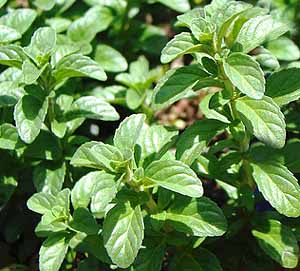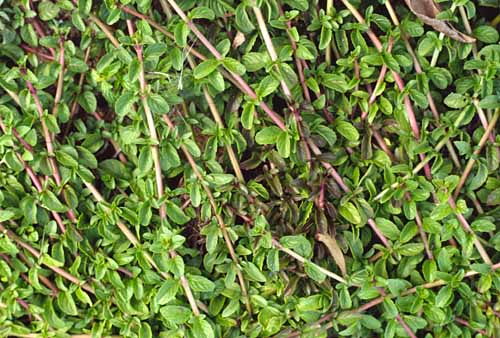Low growing perennial with a strong minty aroma. This plant is aggressive and will take over any area where it is planted. It likes full sun, rich soil and some moisture. It can survive some drought and is not eaten by deer or rabbits.
Description.
Pennyroyal is a perennial with very aromatic minty foliage. It is a member of
the mint family but has a very different habit than most mints. It also can
take quite a few different forms which can arise from the same seed stock without
any apparent reason why one is different from another. In most cases the plant
takes on a creeping form with long stalks that crawl along the ground or hang
down if grown in a pot. The stems are mostly squarish and can grow up to a foot
in length and readily take root at all the joints or nodes along the stem. The
leaves are arranged in opposite pairs with short stalks and gently serrated
or scalloped along the edges. They are mostly roundish oval but in some cases
can be more slender. They are mid green to grayish green depending on location
and 1 1 ½ inches long and ½ wide. The stems can form a dense turf
making it a good ground cover plant growing about four inches tall. .
However in some case the plant can be more erect growing up to 10 inches in
height reaching up to 35 when flowering. This erect form produce more flowers
than the creeping ground cover form. In all cases the flowers appear in July
and August and are borne whorled clusters of ten to twelve rising in tiers one
above the other at the nodes of the stems. The flowers are reddish purple, lilac
or light blue in color, it is followed by the seed which is very small almost
dust like.
IN all cases Pennyroyal can spread aggressively and should either be contained
or grown in a area where its spreading is not a problem.
Note on varieties. All mint plants have a great tendency to hybridize with other varieties and produce strong genetic variation even amongst their own plants. This means that the plants you grow from seed will not all be the same, the aroma, taste and behavior of each plant will vary. If you are intending to grow for culinary or herbal use it is recommended that you grow many more plants than you expect to need then weed out the ones that do not meet your requirements. Other plants can then be propagated from the ones that you have selected by taking cuttings. Mints tend to sprout from cuttings very readily.
Growing.
Seeds of pennyroyal are very small almost dust like, so although they can be
sow directly in the soil after frost danger has passed it is best to start them
inside and grow on to a reasonable size before planting out. This will reduce
weeding of the area. Sow indoors in late winter to early spring for late spring
planting. Germination is usually quick, within a few days of seeding depending
on temperature. Prick plants out into individual pots as they increase in size
and plant in the garden about 12 inches apart, once established expect them
to fill out the whole area where they have been planted like a ground cover.
Location and Care.
Pennyroyal is a aggressive plant that will spread fairly rapidly and will easily
take over an area where it is planted. Ensure you select its location carefully
and don't mind if it spread beyond this. Beating back mint plants once they
start to spread can be a constant battle. It is best not to plant it too close
to other varieties of mint as the two will interbreed and any self seeding between
them will create other mint plants that may not have the characteristics of
either parent.
Pennyroyal prefers full sun but can take some partial shading, it likes a rich
moist well drained soil which is neutral to slightly alkaline (pH 6.0 - 7.0).
It needs the soil to remain slightly moist although it can tolerate some dryness
it cannot tolerate long drought. For established plants the roots may survive
a longer drought and recover the following year but prolonged dry soil will
kill the plant. It can tolerate slightly moister to semi wet soil but not waterlogged
for long periods. It makes an excellent poolside plant.
In cooler zones cut the vertical stalks down to ground level in the fall and
add a layer of mulch over the top of the plants to keep them warm during the
winter. The extra organic material will be an excellent starter for the plants
in the springtime. Pennyroyal is not generally eaten by wildlife. Deer avoid
it so do rabbits.
In small gardens it is recommended that all mints be planted in pots so that they don't totally overtake the garden. Contained in a pot the plant cannot escape and overrun the garden. In cold zone move the pots to a cool garage for the winter and keep the soil just moist. This will ensure that the roots do not freeze solid and plants will recover the following spring. Light is not needed during the winter as the plants die down so the pots can be stacked in a corner with wood sections between them to prevent the plants from being crushed.
Companion planting.
Although it is stated to be a good companion to some plants like carrots and
cabbage the aggressive spreading nature of the plant does not lend itself to
being planted in the vegetable garden. If intending to use as a companion plant
keep the pennyroyal in pots in the vegetable garden .
Harvesting.
It is not recommended that stems be harvested until the second year when growing
from seed. Allow the plant one year to establish itself. If however the plant
does really well stems can be harvested when they reach six inches in length.
During the second year, continuous harvesting can be carried out as this will
encourage new growth on the plant. Never take more than one third of the plant
at one harvest and cut the young stalks close to the ground but leave several
leaves and portion of the stalk to encourage more growth. Always harvest when
the stalks and leaves are totally dry.
Dry the plant material either on screens in the sunshine or in a dehydrator,
store in airtight containers until needed.
Pests and diseases
Can suffer from Verticillium wilt, rust (especially if fertilized with manure),
anthracnose Spider mites, some aphids
Uses.
Pennyroyal has been used in culinary dishes by the Greeks and Romans. The lovely
minty flavor is used in flavoring, vinegar's, for teas. It can be added to desserts
drinks and dips.
Medical uses.
Rubbing the freshly cut leaves on the skin is said to repel flies, gnats, chiggers,
ticks and mosquitoes. The oil is used in aromatherapy. It has been used medicinally
since Roman times for many ailments especially to provoke menstruation as well
as facilitating child birth. It is also used to relive dizziness and vertigo.
Like all mints is it useful to help digestion, flatulence and stomach problems.









